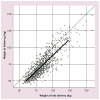Changes in maternal weight 5-10 years after a first delivery
- PMID: 22934725
- PMCID: PMC3544935
- DOI: 10.2217/whe.12.35
Changes in maternal weight 5-10 years after a first delivery
Abstract
Aim: The objective of this study was to identify maternal, obstetrical and reproductive factors associated with long-term changes in maternal weight after delivery.
Materials & methods: Participants were enrolled in a longitudinal cohort study of maternal health 5-10 years after childbirth. Data were obtained from obstetrical records and a self-administered questionnaire. Weight at the time of first delivery (5-10 years prior) was obtained retrospectively and each woman's weight at the time of her first delivery was compared with her current weight.
Results: Among 948 women, obesity was associated with race, parity, education, history of diabetes and history of cesarean at the time of first delivery. On average, the difference between weight at the time of first delivery and weight 5-10 years later was -11 kg (11 kg weight loss). In a multivariate model, black race and diabetes were associated with significantly less weight loss. Cesarean delivery, parity and breastfeeding were not associated with changes in maternal weight.
Conclusion: Black women and those with a history of diabetes may be appropriate targets for interventions that promote a long-term healthy weight after childbirth.
Figures


Similar articles
-
The effect of gestational weight gain by body mass index on maternal and neonatal outcomes.J Obstet Gynaecol Can. 2009 Jan;31(1):28-35. doi: 10.1016/s1701-2163(16)34050-6. J Obstet Gynaecol Can. 2009. PMID: 19208280
-
The maternal childbirth experience more than a decade after delivery.Am J Obstet Gynecol. 2017 Sep;217(3):342.e1-342.e8. doi: 10.1016/j.ajog.2017.04.027. Epub 2017 Apr 25. Am J Obstet Gynecol. 2017. PMID: 28455080
-
Impact of first childbirth on changes in women's preference for mode of delivery: follow-up of a longitudinal observational study.Birth. 2008 Jun;35(2):121-8. doi: 10.1111/j.1523-536X.2008.00225.x. Birth. 2008. PMID: 18507583
-
Non-medical factors affecting antenatal preferences for delivery route and actual delivery mode of women in southwestern Iran.J Matern Fetal Neonatal Med. 2016 Nov;29(22):3622-8. doi: 10.3109/14767058.2016.1140137. Epub 2016 Feb 24. J Matern Fetal Neonatal Med. 2016. PMID: 26753876
-
Maternal body mass index as a predictor for delivery method.Acta Obstet Gynecol Scand. 2018 Feb;97(2):212-218. doi: 10.1111/aogs.13265. Epub 2017 Dec 14. Acta Obstet Gynecol Scand. 2018. PMID: 29164597
Cited by
-
Association of Delivery Mode With Pelvic Floor Disorders After Childbirth.JAMA. 2018 Dec 18;320(23):2438-2447. doi: 10.1001/jama.2018.18315. JAMA. 2018. PMID: 30561480 Free PMC article.
-
Association between parity and persistent weight gain at age 40-60 years: a longitudinal prospective cohort study.BMJ Open. 2019 May 5;9(5):e024279. doi: 10.1136/bmjopen-2018-024279. BMJ Open. 2019. PMID: 31061020 Free PMC article.
References
-
- Ford ES, Li C, Zhao G, et al. Trends in obesity and abdominal obesity among adults in the United States from 1999–2008. Int J Obes (Lond) 2011;35:736–743. - PubMed
-
- Ogden CL, Carroll MD, Kit BK, Flegal KM. NCHS Data Brief. 82. National Center for Health Statistics; Hyattsville, MD, USA: 2012. Prevalence of Obesity in the United States, 2009–2010. National statistics from the USA suggest that obesity affects a third of US adults, with the highest rates of obesity in women over 60 years of age. - PubMed
-
- Ogden CL, Carroll MD, Lester CR, et al. Prevalence and trends in obesity among US adults, 1999–2004. JAMA. 2006;295:1549–1555. - PubMed
-
- Crowell DT. Weight change in the postpartum period: a review of the literature. J Nurse Midwifery. 1995;40:418–423. - PubMed

